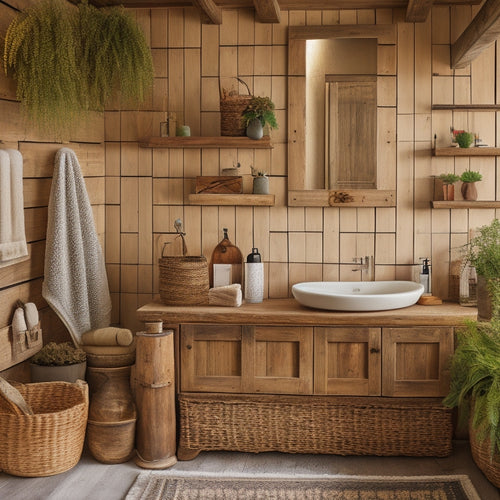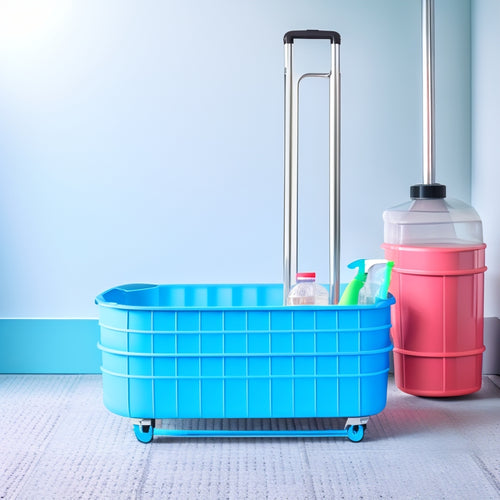
Master the Art of Crafting Fabric Bins
Share
You're about to discover the secrets to creating stunning fabric bins that are both functional and beautiful. Start by choosing the right mid-weight woven fabric and preparing it by ironing out wrinkles and creases. Master essential sewing techniques like cutting, applying interfacing, and sewing, and don't forget to add fusible fleece or foam for structure and stability. Create perfect straps by cutting identical fabric and interfacing pieces and fusing them together. As you build your fabric bin, follow step-by-step instructions and consider storage organization. With these basics down, you're ready to add your personal touch and create a unique piece that reflects your style.
Key Takeaways
• Choose high-quality, mid-weight woven fabric that lies flat and even to ensure stability of the bin.
• Master essential sewing techniques, including cutting, interfacing, and topstitching, for a professional finish.
• Use fusible fleece or foam to add structure and stability, and prevent straps from stretching or distorting over time.
• Follow pattern instructions carefully and consider storage organization while assembling the bin to create a clutter-free space.
• Experiment with different fabrics, colors, and textures, and add embellishments like custom labels or embroidery to personalize your bin.
Fabric Selection and Preparation
Selecting the right fabric is important to creating a sturdy and attractive fabric storage bin. Choose a mid-weight woven fabric like quilting cotton or cotton canvas that can hold its shape and support the bin's structure.
When choosing materials, consider the weight and texture of the fabric. You want a fabric that's not too thin or too thick, as it may affect the bin's stability.
Preparing your fabric is also vital. Make sure to iron your fabric to remove any wrinkles and creases. This will guarantee that your fabric lies flat and even, making it easier to work with.
Mastering Sewing Techniques
Your sewing skills will be put to the test as you tackle the important steps of cutting, applying interfacing, and sewing the straps and main body of your fabric storage bin.
To guarantee success, master the art of cutting and applying interfacing to your fabric, using medium-weight woven interfacing for a smooth finish. Don't forget to add fusible fleece or foam for structure and stability.
When sewing the main body, use topstitching tips to create a professional-looking finish. Lining secrets, such as sewing the lining to the main body, will also be essential.
Creating the Perfect Straps
You'll create sturdy, comfortable straps by cutting two identical fabric pieces and two interfacing pieces, then fusing the interfacing to the wrong side of the fabric. This guarantees a smooth, even finish and prevents the straps from stretching or distorting over time.
To achieve the perfect straps, consider the following key factors:
-
Strap attachment: Decide how you want to attach the straps to the bin, such as with rivets or reinforced stitching.
-
Strap length: Choose a length that suits your needs, taking into account the size of the bin and how you plan to use it.
-
Customization and functionality: Consider adding features like adjustable straps or reinforced stress points to enhance the bin's functionality and overall user experience.
Building the Fabric Bin
Now that you've created sturdy straps, it's time to assemble the fabric bin by cutting out the main body and lining pieces according to the pattern.
For a professional finish, use a walking foot to guarantee even fabric feeding and prevent puckering.
Cut out the required fabric pieces, applying interfacing and foam as needed for structure and stability.
Next, sew the main body and lining together, following the pattern's step-by-step instructions.
As you assemble the fabric bin, keep in mind the importance of storage organization and how your DIY home decor project will contribute to a clutter-free space.
With attention to detail and precision, you'll be on your way to creating a beautiful and functional fabric bin that complements your home's aesthetic.
Finishing Touches and Tips
Finishing the fabric storage bin requires attention to detail, as the final touches can make a significant difference in its overall appearance and functionality. To take your bin to the next level, follow these expert tips:
-
Master topstitching secrets: Use a walking foot to guarantee even feeding and prevent puckering. Press your seams as you go to achieve pressing perfection.
-
Explore embellishment ideas: Add a personal touch with custom labels, appliques, or embroidery. You can also try different stitching patterns or thread colors to give your bin a unique look.
-
Customization options are endless: Try using different fabrics, colors, or textures to create a one-of-a-kind bin that reflects your personal style. Don't be afraid to experiment and make it your own!
Frequently Asked Questions
Can I Use Different Fabrics for the Outer and Inner Layers?
Imagine a bin with a soft, cotton outer layer and a sturdy, canvas inner layer - yes, you can use different fabrics for the outer and inner layers, creating contrasting textures and coordinated prints that add visual interest!
How Do I Adjust the Pattern for a Round Fabric Storage Bin?
To create a round fabric storage bin, you'll need to adjust the pattern by applying circle calculations to manipulate the shape, then re-draft the pattern pieces to accommodate the new curved design.
What Is the Best Way to Clean and Maintain Fabric Storage Bins?
As you tenderly dust off your treasured fabric storage bins, remember to gently vacuum or spot clean stains, and periodically give them a fabric refresh by steaming or airing out to maintain their vibrant charm.
Can I Add Pockets or Dividers to the Fabric Storage Bin?
You can easily add pockets or dividers to your fabric storage bin by strategically planning Pocket Placement and clever Divider Design, ensuring a functional and organized space that meets your specific needs.
Are Fabric Storage Bins Suitable for Outdoor or Wet Environments?
You might think fabric storage bins are too delicate for outdoor or wet environments, but they can be made to withstand the elements with water-resistant fabric and UV protection, making them a great option for outdoor storage.
Related Posts
-

Rustic Bathroom Storage Under $100
You can easily boost your bathroom's charm and functionality with rustic storage solutions under $100. Consider using...
-

Revamp Your Cleaning Business With This Checklist
Revamping your cleaning business requires a strategic overhaul of operational inefficiencies, starting with the imple...
-

Bronze Bathroom Organizer: Stylish Space-Saving Solution
Bronze bathroom organizers effortlessly combine elegant design with efficient storage solutions, providing a sophisti...


